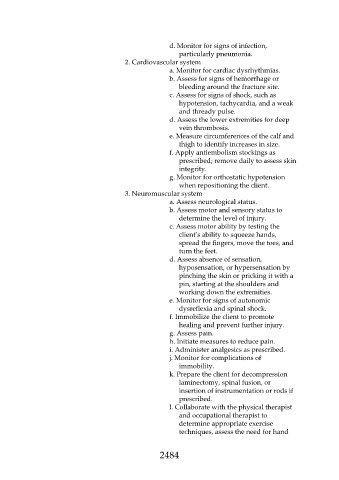Page 2484 - Saunders Comprehensive Review For NCLEX-RN
P. 2484
d. Monitor for signs of infection,
particularly pneumonia.
2. Cardiovascular system
a. Monitor for cardiac dysrhythmias.
b. Assess for signs of hemorrhage or
bleeding around the fracture site.
c. Assess for signs of shock, such as
hypotension, tachycardia, and a weak
and thready pulse.
d. Assess the lower extremities for deep
vein thrombosis.
e. Measure circumferences of the calf and
thigh to identify increases in size.
f. Apply antiembolism stockings as
prescribed; remove daily to assess skin
integrity.
g. Monitor for orthostatic hypotension
when repositioning the client.
3. Neuromuscular system
a. Assess neurological status.
b. Assess motor and sensory status to
determine the level of injury.
c. Assess motor ability by testing the
client’s ability to squeeze hands,
spread the fingers, move the toes, and
turn the feet.
d. Assess absence of sensation,
hyposensation, or hypersensation by
pinching the skin or pricking it with a
pin, starting at the shoulders and
working down the extremities.
e. Monitor for signs of autonomic
dysreflexia and spinal shock.
f. Immobilize the client to promote
healing and prevent further injury.
g. Assess pain.
h. Initiate measures to reduce pain.
i. Administer analgesics as prescribed.
j. Monitor for complications of
immobility.
k. Prepare the client for decompression
laminectomy, spinal fusion, or
insertion of instrumentation or rods if
prescribed.
l. Collaborate with the physical therapist
and occupational therapist to
determine appropriate exercise
techniques, assess the need for hand
2484

